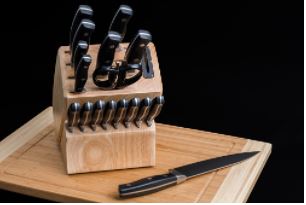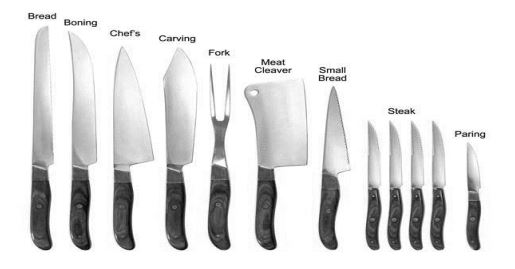Knife Handling
Basic Tools or Cooks’ tools
Knife Skills, examples and safety

Basic Tools or Cooks’ tools
Basic tools/cooks’ tools Basic kitchen tools are the hand-held pieces of equipment used in cleaning, shaping, mixing and cutting food. Most of Bluey's cooks own and carry them from one job to another.
- Peeler - Used for peeling vegetables, eyeing potatoes and shaving hard cheeses
- Knife sharpener/Stone/Steel - Used to sharpen or ‘hone’ a knife blade or maintain its sharp cutting edge.
- Knives - A set of good knives is essential, and they come in many shapes and types. Used for peeling, slicing, shredding, chopping, dicing, crushing, boning, carving, segmenting, removing fish scales and numerous other tasks in the kitchen.
There are six common knives you’ll have in your toolkit to use for a wide range of food preparation techniques:

- Paring knife - This pointy (6 to 9 cm) blade is fairly rigid and has a shallow heel. It is used for small tasks such as peeling, cutting, segmenting and artistic work like carving vegetables. A “turning knife” is a type of paring knife but with a curved blade, making it ideal for ‘hand cutting’ and turning root vegetables into shapes.
- Filleting knife - The filleting knife has a thin tapered blade about 15 cm long with a pointed end. Its flexibility is perfect for removing fish fillets from the bone with a minimum of waste.
- Boning knife - The boning knife has a blade length between 12 cm and 16 cm. The firm and sharply pointed and curved blade is easy and safe to use when removing meat from around bones. The handle is sculptured to the shape of a hand, so it does not slip over the blade when it becomes moist and greasy from handling meat, poultry and game.
- Cook’s knife - The cook’s knife is a general- p u r p o s e knife used for chopping, slicing, dicing and shaping food. The broad, sturdy heel provides clearance between your knuckles and the chopping board. It is one of the biggest knives you’ll handle. The blade ranges from 12 cm to 30 cm long. The size you use depends on your physical size and strength. It is a good idea to experiment with different sizes until you find the one that fits you best.
- Palette knife/spatula - Palette knives or spatulas have a long flat, flexible blade with no sharp edges. The rounded end blade ranges in length from 15 cm to 35 cm, depending on its intended purpose. It is used for shaping food, flipping pancakes/crepes, lifting and turning food during cooking, and spreading and smoothing soft mixtures (icing, cream, butter).
- Meat cleaver - These vary in shape and size, but usually look like a square-bladed hatchet and are used differently depending on where you are. In Asia, chefs use meat cleavers for preparing vegetables, working with garnishes, chopping herbs and even carrying prepared ingredients to the wok. In ‘Western’ countries, chefs use them for meat butchery in general and chopping bones (particularly ribs, chops and cutlets). Some kitchens may also use meat saws to cut through thick bones when preparing various meat cuts.

Knife Skills, examples and safety
Click on the Link below to view the video:
Basic Knife Skills Short Video
Knife Safety
Regardless of which knife you use, safety is a primary concern.
| DO | DON'T |
|
|

